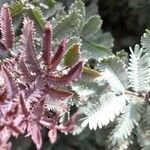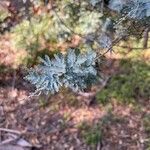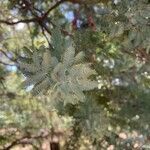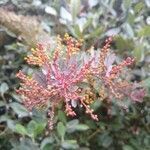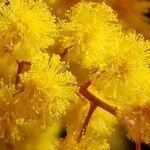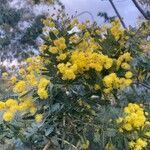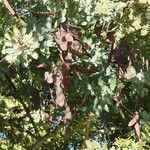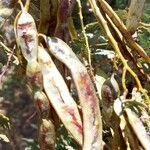Unarmed shrub or tree up to 5 m high; young branchlets subglabrous to sparingly pubescent. Leaves bipinnate, glaucous: petiole very short, 2-8 mm long; rhachis 0-1.2 cm long, with a gland at the junction of each or only the top few pinnae pairs; pinnae (1)2-4 pairs, crowded; leaflets 12-20 pairs, 3-7 x 0.8-1.5 mm, linear-oblong, often slightly falcate, glabrous throughout or with few marginal cilia. Inflorescences capitate, in axillary racemes or panicles longer than the leaves. Flowers bright yellow; peduncles 2-5 mm long. Calyx and corolla glabrous or almost so. Pods brown, 4-10 x 0.8-1.4 cm, straight or slightly curved, margins entire or only slightly and irregularly constricted between some of the seeds, dehiscing longitudinally along one margin. Seeds blackish, ±6 x 3 mm, smooth; caruncle conspicuous; areole ±5 x 2 mm.
Small, unarmed tree to 3 m high. Branchlets angular, glabrous or pubescent. Leaves bipinnate, glaucous, pinnae and leaflets approximate, leaves consequently making an impression of being entire, rachis 1-3 cm, petiole 0.1-0.2 cm, glabrous to tomentose, rachis glands at junction of pinnae, circular, concave, c. 1 mm in diameter; pinnae 2-4(-6) pairs, 1-2.5 cm; leaflets opposite, sessile, (4-) 12-24 pairs per pinna, linear, often slightly curved, 3-8 by 0.7-1.6 mm, glabrous. Inflorescences 6-12.5 cm long racemes with flower heads of 10-20 flowers, much longer than the leaves, the terminal racemes often aggregated into a panicle, rachis glabrous or subglabrous. Pod strap-shaped, 5-10.5 by 0.9-1.2 cm, 10-13-seeded, funicle short.
Tree or shrub, 3-6 m high, covered with grey-blue powdery bloom. Leaves bipinnate, greyish to silvery blue, tinged purple, 20-50 mm long, rachis up to 12 mm long, pinnae 2-4 pairs, crowded, each with 12-20 leaflet pairs. Flowers globular heads in axillary racemes, bright yellow. Flowering time July-Sept. Pod greyish brown, 40-100 x 8-14 mm, straight or slightly curved, irregularly constricted between some seeds, dehiscent.
Unarmed, evergreen, small tree, 3-9 m, with branches and leaves covered with a greyish or bluish, powdery bloom. Leaves bipinnate, greyish or silvery blue, sometimes tinged purple. Flowers in globose heads, bright yellow. Pods greyish brown.
Unarmed shrub or tree, up to 5 m high. Leaves with 1-4 pinnae pairs; leaflets 1.5-5.0 mm long, narrower than 2 mm; petiole and rhachis together shorter than 25 mm. Inflorescence longer than leaves. Flowers bright yellow.
Leaves 2-pinnate, glaucous; petiole very short, c. 2 mm.; pinnae in 2-5 pairs, crowded, c. 0.8-3 cm. long; leaflets 3-8 x 0.8-1.5 mm., glabrous or subciliate on the margins only.
A shrub or small tree. It grows 3-10 m tall. It has twice divided leaves. The leaflets are 23 cm long and silvery grey The flowers are yellow and round in clusters.
Shrub or tree 5-10 m. high, unarmed; young branchlets ± inconspicuously pubescent.
Flowers yellow, in heads arranged in axillary racemes longer than the leaves.

